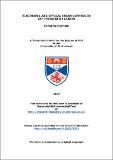Files in this item
Electronic and optical SESAM control in Cr⁴⁺:forsterite lasers
Item metadata
| dc.contributor.advisor | Brown, C. Tom A. | |
| dc.contributor.advisor | Sibbett, Wilson | |
| dc.contributor.author | Crombie, Christine | |
| dc.coverage.spatial | ix, 133 | en_US |
| dc.date.accessioned | 2013-06-03T14:44:26Z | |
| dc.date.available | 2013-06-03T14:44:26Z | |
| dc.date.issued | 2013 | |
| dc.identifier.uri | https://hdl.handle.net/10023/3593 | |
| dc.description.abstract | The work documented in this thesis is based on the production, manipulation and control of ultrashort laser pulses in the near infra-red region of the electromagnetic spectrum. Pulses were created using Cr⁴⁺:Forsterite as a gain crystal with the SESAM mode-locking technique. The aim of the work presented was to use the SESAM as a control device within the laser in addition to its function as the mode-locking element. In this thesis two methods of SESAM based control were investigated. The first technique, optical switching, used an auxiliary diode laser operating with a wavelength of 640 nm, to pump the SESAM in addition to the intra-cavity field of the Cr⁴⁺:Forsterite laser. The localised heating effect induced a change in the absorption spectrum of the SESAM, in turn changing the operating regime of the laser. Using this technique it was possible to switch between pulses of duration 34.5 ps to 263 fs in timescales of 1-3 ms. The return switching time was 0.5 ms. The effect of diode pump power on switching times and stability was also investigated, showing the possibility of controlling these aspects by monitoring the applied power. The second technique was an all-electrical control technique and in this case SESAM control was achieved by reverse biasing the device to induce the quantum confined Stark effect. This also changed the absorption spectrum of the SESAM and switching was achieved. In this work three SESAM designs were used, each with a different QW shape making up the absorber layer. With a square well device, switching was achieved between 6.42 ps to 2.85 fs and 116 ps to CW operation with switching time ~20ms. A device with a pair of QWs (with separation 2nm,facilitating quantum tunnelling) was then used. With this device switching was achieved from 188 fs to a regime which appeared to be producing Q-switched pulses.A stepped geometry QW device was also tested, but had insufficient absorption to induce mode-locking. The results obtained show that both switching techniques are viable control methods for the Cr⁴⁺:Forsterite laser, and indicate that there is also potential to use SESAM control in other solid-state lasers. | en_US |
| dc.language.iso | en | en_US |
| dc.publisher | University of St Andrews | |
| dc.subject.lcc | TA1688.C8 | en_US |
| dc.subject.lcsh | Mode locked lasers | en_US |
| dc.subject.lcsh | Laser pulses, Ultrashort | en_US |
| dc.subject.lcsh | Command and control systems | en_US |
| dc.title | Electronic and optical SESAM control in Cr⁴⁺:forsterite lasers | en_US |
| dc.type | Thesis | en_US |
| dc.type.qualificationlevel | Doctoral | en_US |
| dc.type.qualificationname | PhD Doctor of Philosophy | en_US |
| dc.publisher.institution | The University of St Andrews | en_US |
This item appears in the following Collection(s)
Items in the St Andrews Research Repository are protected by copyright, with all rights reserved, unless otherwise indicated.

